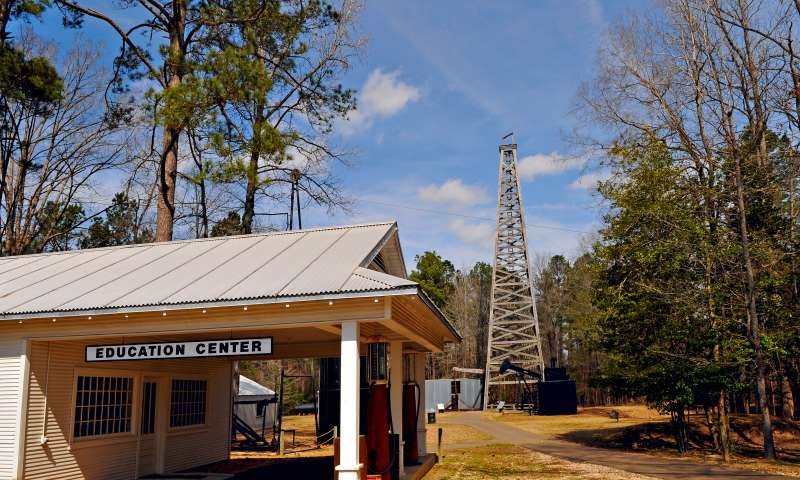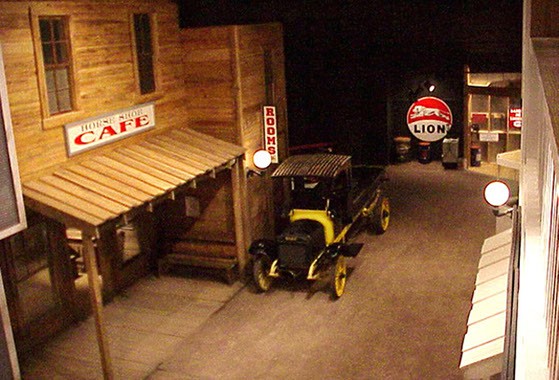Arkansas Museum of Natural Resources
Introduction
Text-to-speech Audio
Images
Picture that shows some of the working examples of oil equipement that can be found at Oil Field park. These machines would have been used in the 1920s at the height of the boom.

One of the exhibit within the Museum is a example town to help vistors experience what Smackover would have been like in the 1920s.

Backstory and Context
Text-to-speech Audio
Before 1922, Smackover, Arkansas was a quiet town that depended upon cotton farming and timber. There were not many opportunities for the town until Sidney Umsted "struck gold" or more accurately - struck oil. Umsted had believed for years that oil was beaming beneath the land of Smackover and he would be proven right on July 1st 1992 when a well at the depth of 2,066 feet would erupt with oil. "Within six months, 1,000 wells had been drilled, with a success rate of ninety-two percent. The little town had increased from a mere ninety to 25,000, and its uncommon name would quickly attain national attention.” Smackover would become the largest oil producing field in the world by 1925.
The rapid pace that the town grew would lead to complications with criminal activity. Lawlessness was a large issue in Smackover during the oil boom. The lack of authority and respect for law would lead to a large multi day riot. There is debate about exactly how the Smackover Riot began, but it is rumored to have began because of a murder that occurred within town. The result of the murder led to a “clean up” crew being established to rid the town of the “undesirables.” Undesirables were considered to be those that participated in gambling or saloon goers. There are many unconfirmed reports of the riot and it is unclear how many people were wounded or killed. The riot succeeded in pushing many people out of town, undesirables and businesses.
Large oil companies chose to move to different places to settle their business leaving the town with a decreasing population. The oil boom in Smackover also quickly died out due to the lack of environmental protection. The oil pressure, which allowed the oil to be easier to extract, was used up by 1923 and the Smackover population would continue to decrease from 25,000 to 2,500. While the Oil boom was relatively short for Smackover, Arkansas, it had a lasting impact on the town. Still today, the oil industry supports fifty percent of the town residents. The town also celebrates its history with an Oil Town Festival every year since 1971.
The Arkansas Natural Resources Museum was established in 1986 and its mission is "to collect, preserve, and exhibit and interpret Arkansas’s natural resources with particular interest in petroleum and brine used for bromine extraction." The Museum is set up within part of the historic oil field and features exhibits inside to mimic what the historic town of Smackover would have been like. The outside area of the museum features the Oil Field Park with operating examples of equipment that would have been used to extract oil or bromine.
Sources
Aoghs.org Editors. Oil discoveries at El Dorado and Smackover brought 1920s drilling booms., AMERICAN OIL & GAS HISTORICAL SOCIETY. April 21st 2013. Accessed November 29th 2020. https://www.aoghs.org/petroleum-pioneers/arkansas-oil-and-gas-boom-towns/.
Arkansas Museum Natural Resources Friends Foundation. Arkansas Museum of Natural Resources. Accessed November 16th 2020. http://www.amnr.org/galleries.html.
City of Smackover. Our History, Smackover. Accessed November 20th 2020. https://smackover.org/our-history#:~:text=When%20land%20grant%20settlers%20settled,largest%20oil%20reservoirs%20in%201922..
Griffith, Nancy Snell. Smackover Riot of 1922, Encyclopedia of Arkansas. February 10th 2014. Accessed November 20th 2020. https://encyclopediaofarkansas.net/entries/smackover-riot-of-1922-7941/.
Lambert, Don. Smackover (Union County), Encyclopedia of Arkansas. September 16th 2019. Accessed November 23rd 2020. https://encyclopediaofarkansas.net/entries/smackover-union-county-1000/.
The daily star-mirror. (Moscow, Idaho), 24 Nov. 1922. Chronicling America: Historic American Newspapers. Lib. of Congress. https://chroniclingamerica.loc.gov/lccn/sn89055128/1922-11-24/ed-1/seq-4/
https://www.arkansasstateparks.com/parks/arkansas-museum-natural-resources
http://www.amnr.org/events.html
